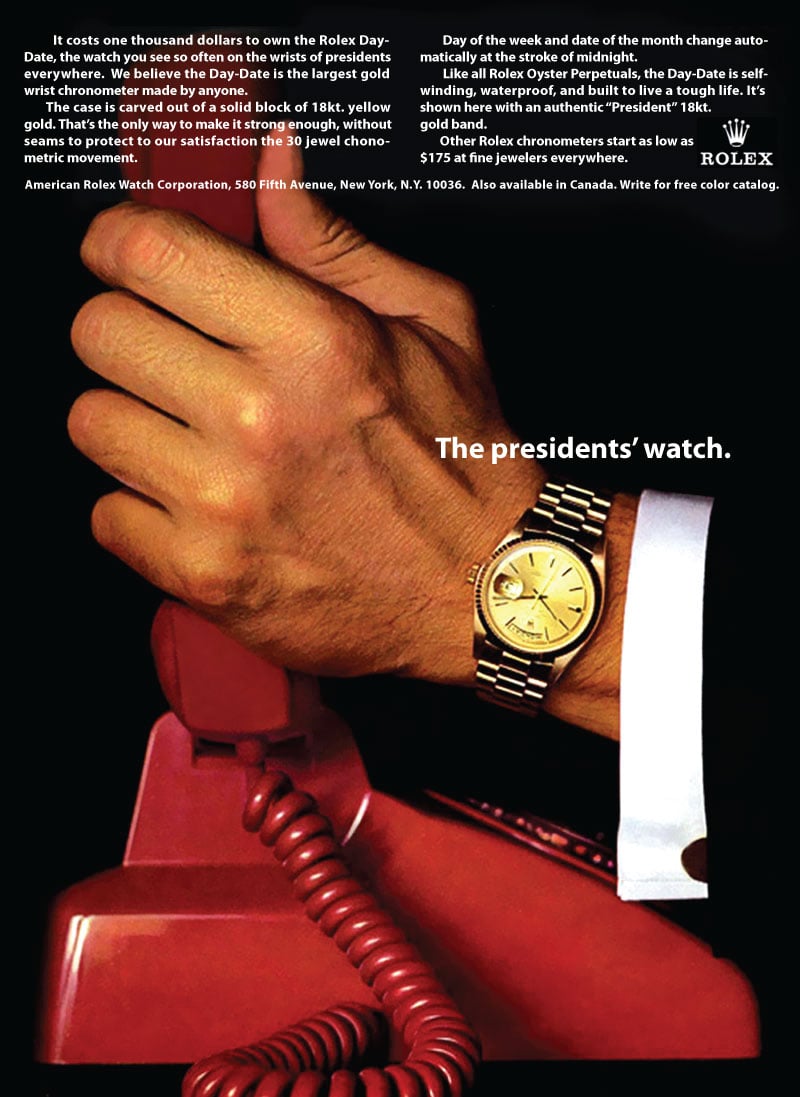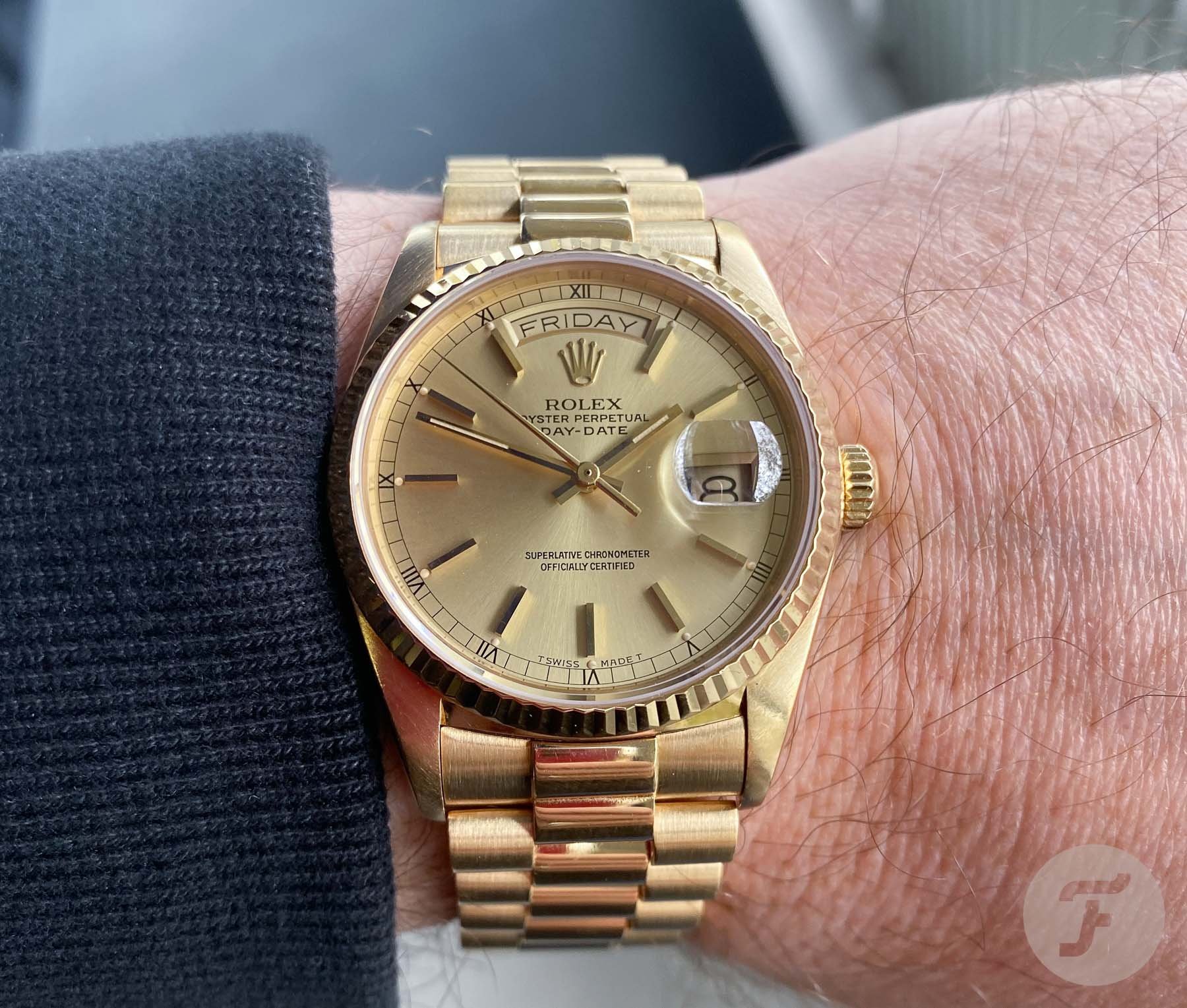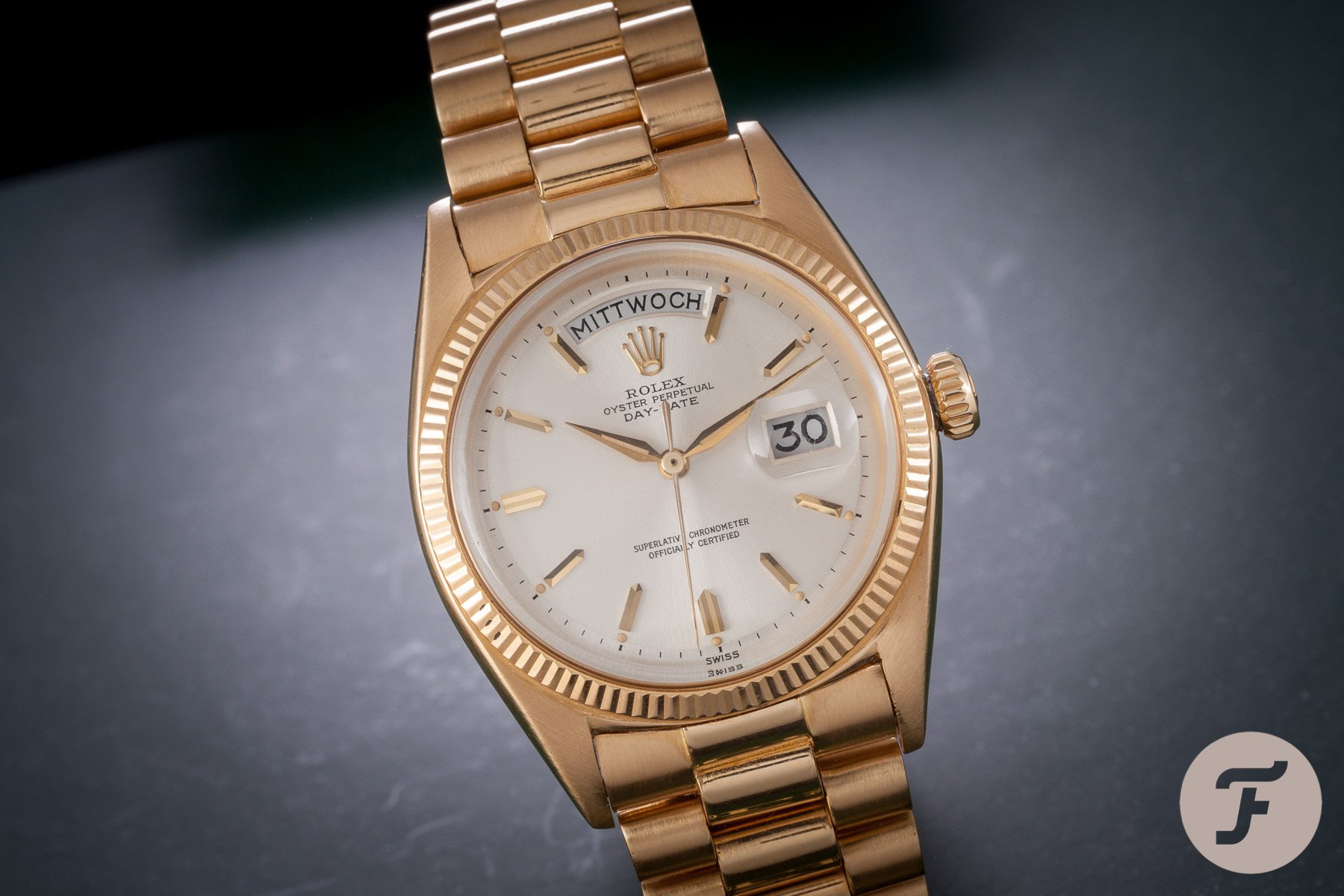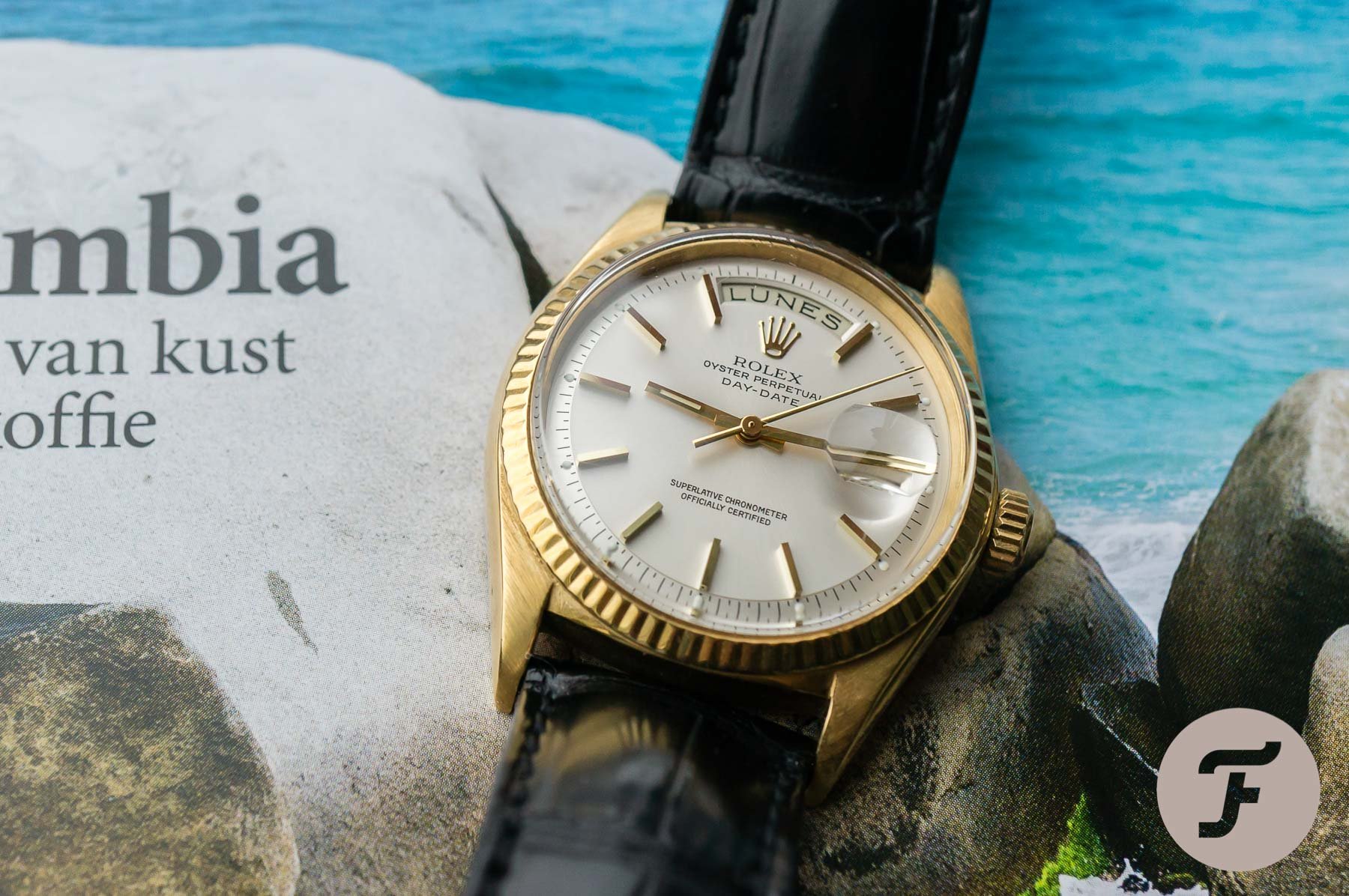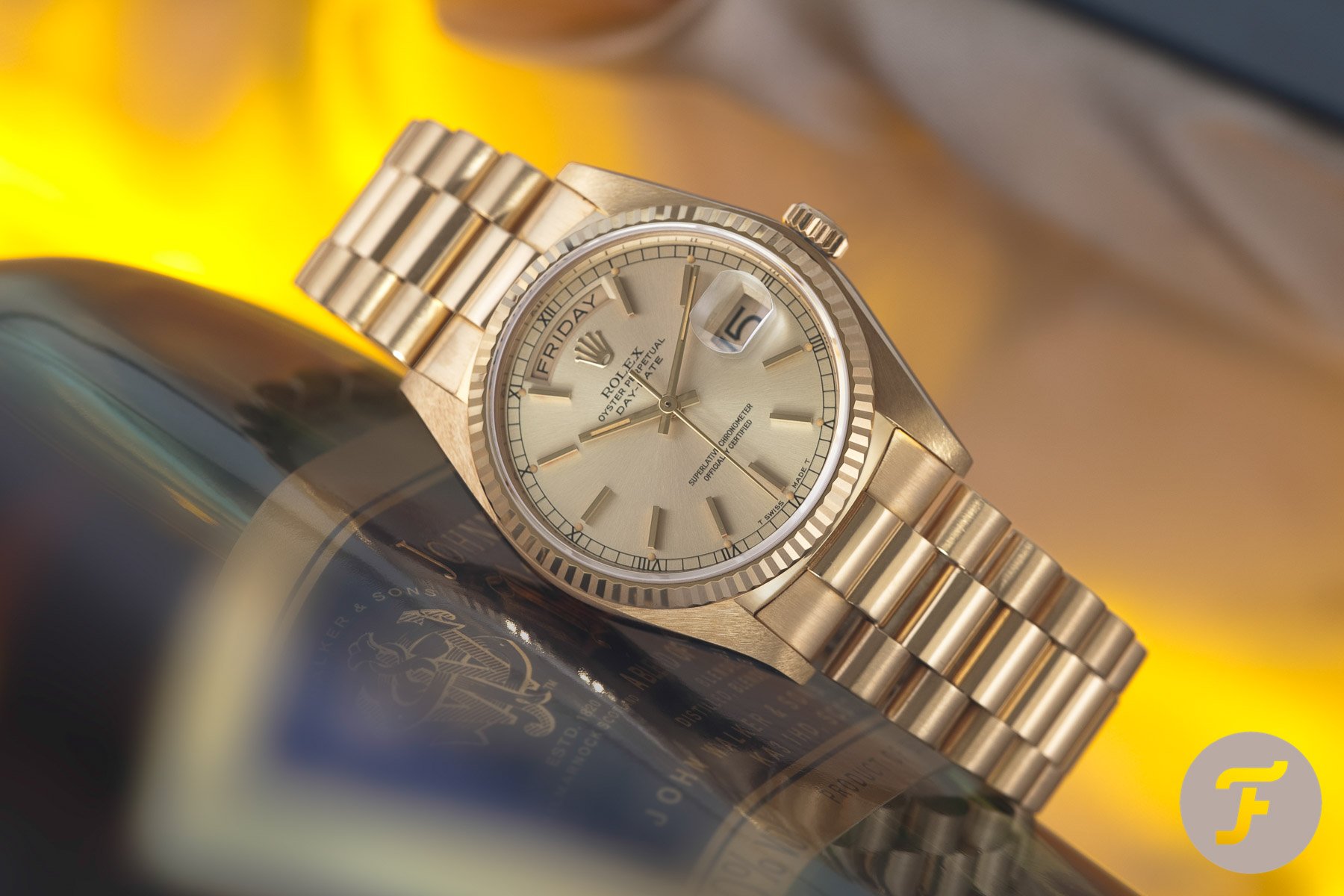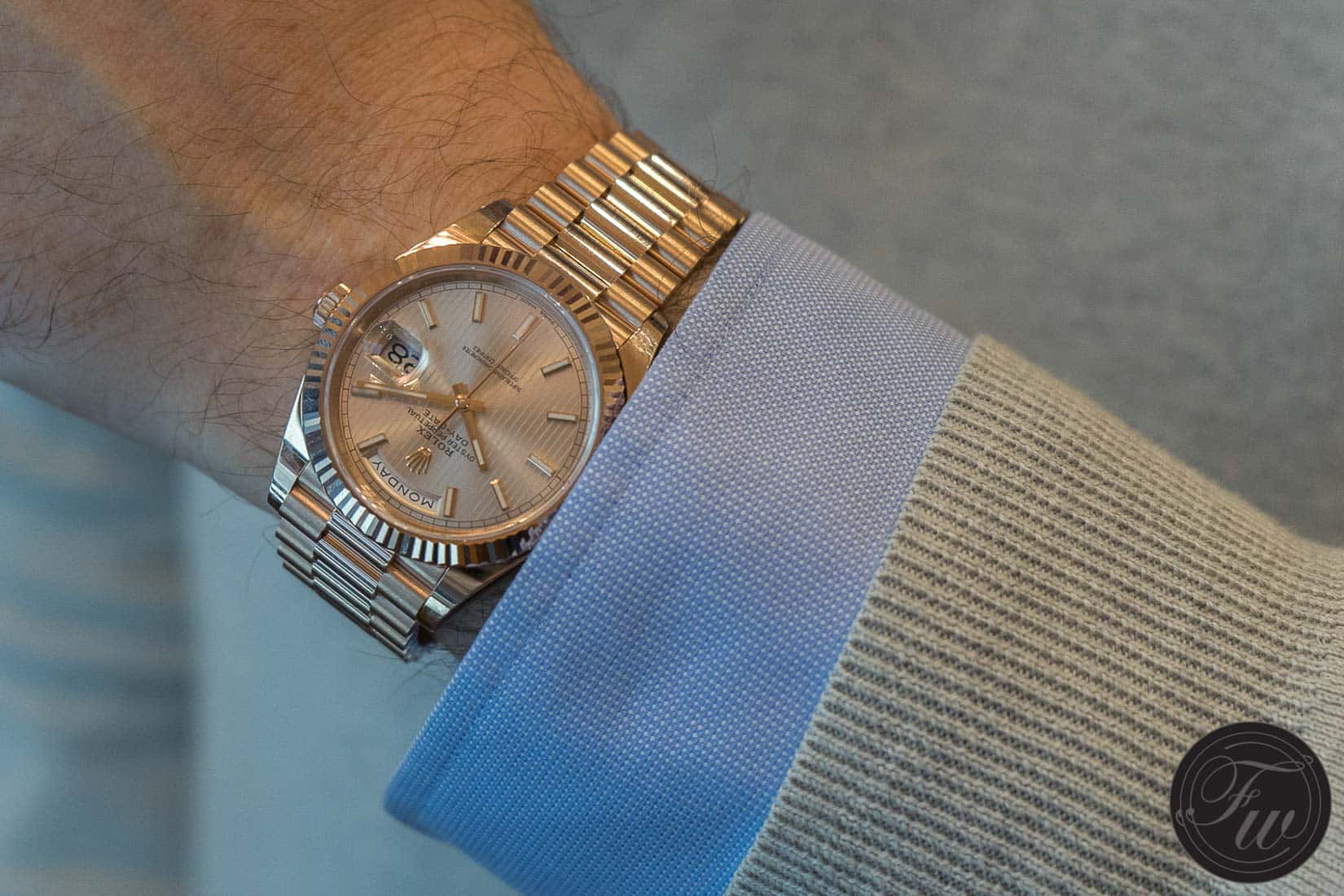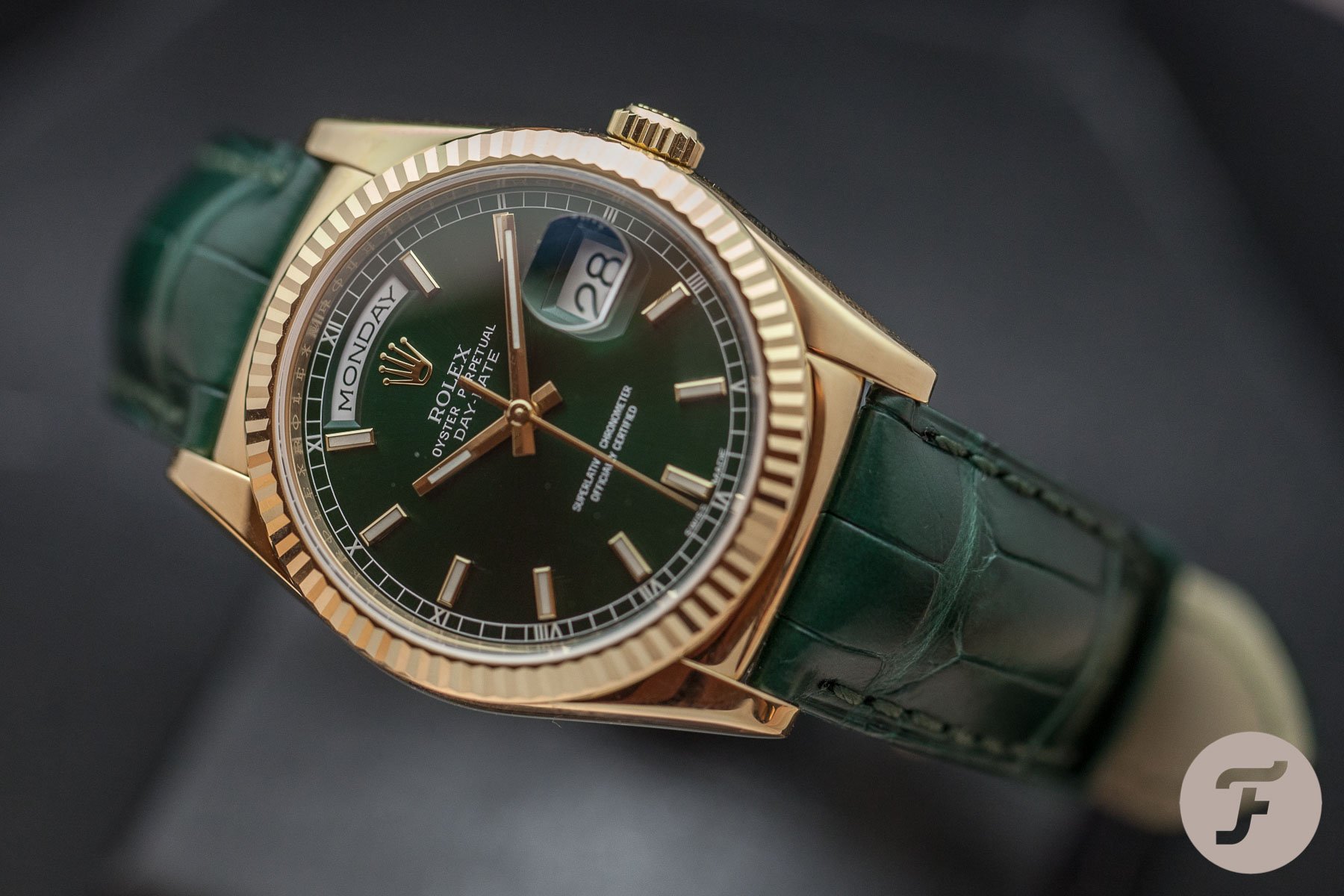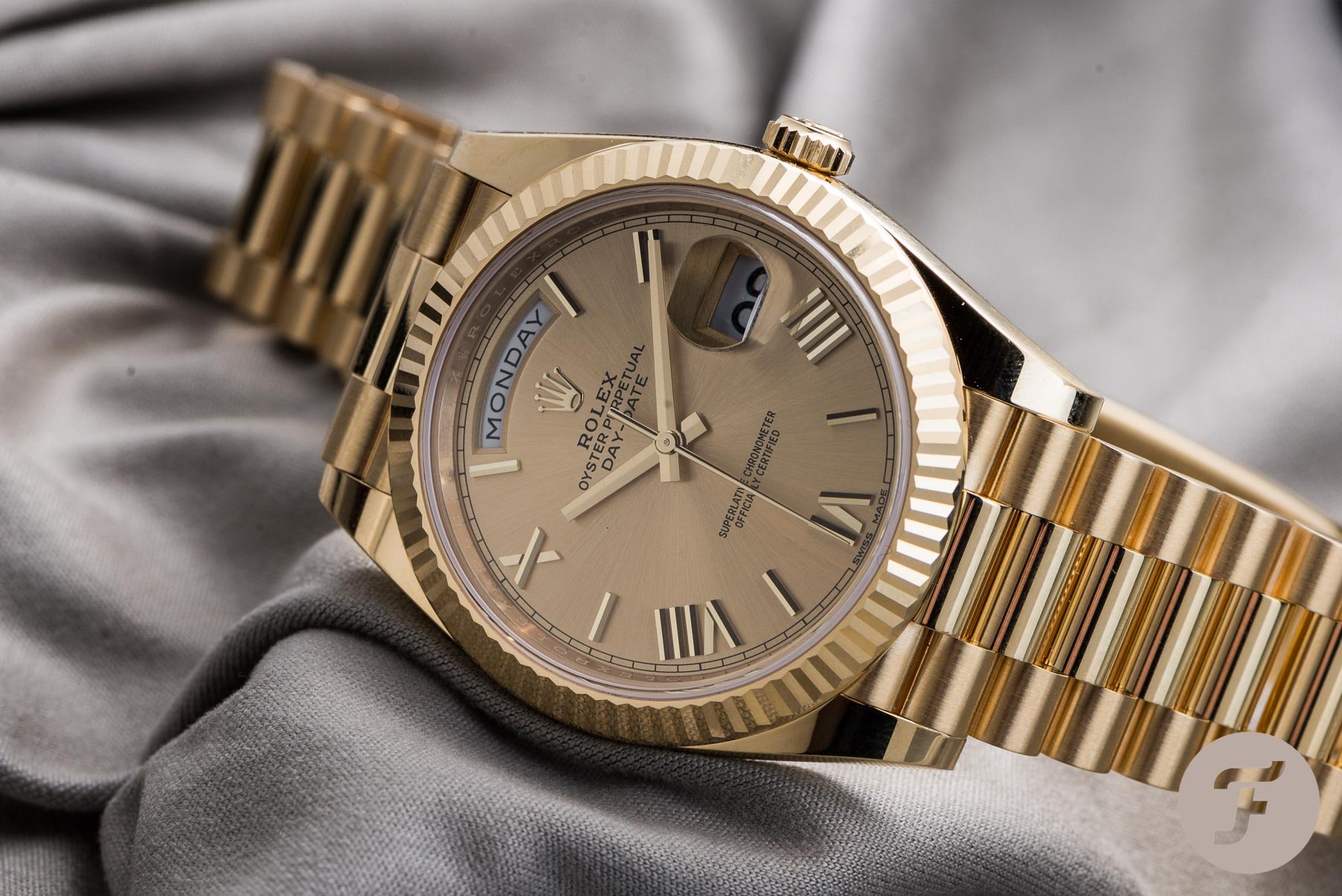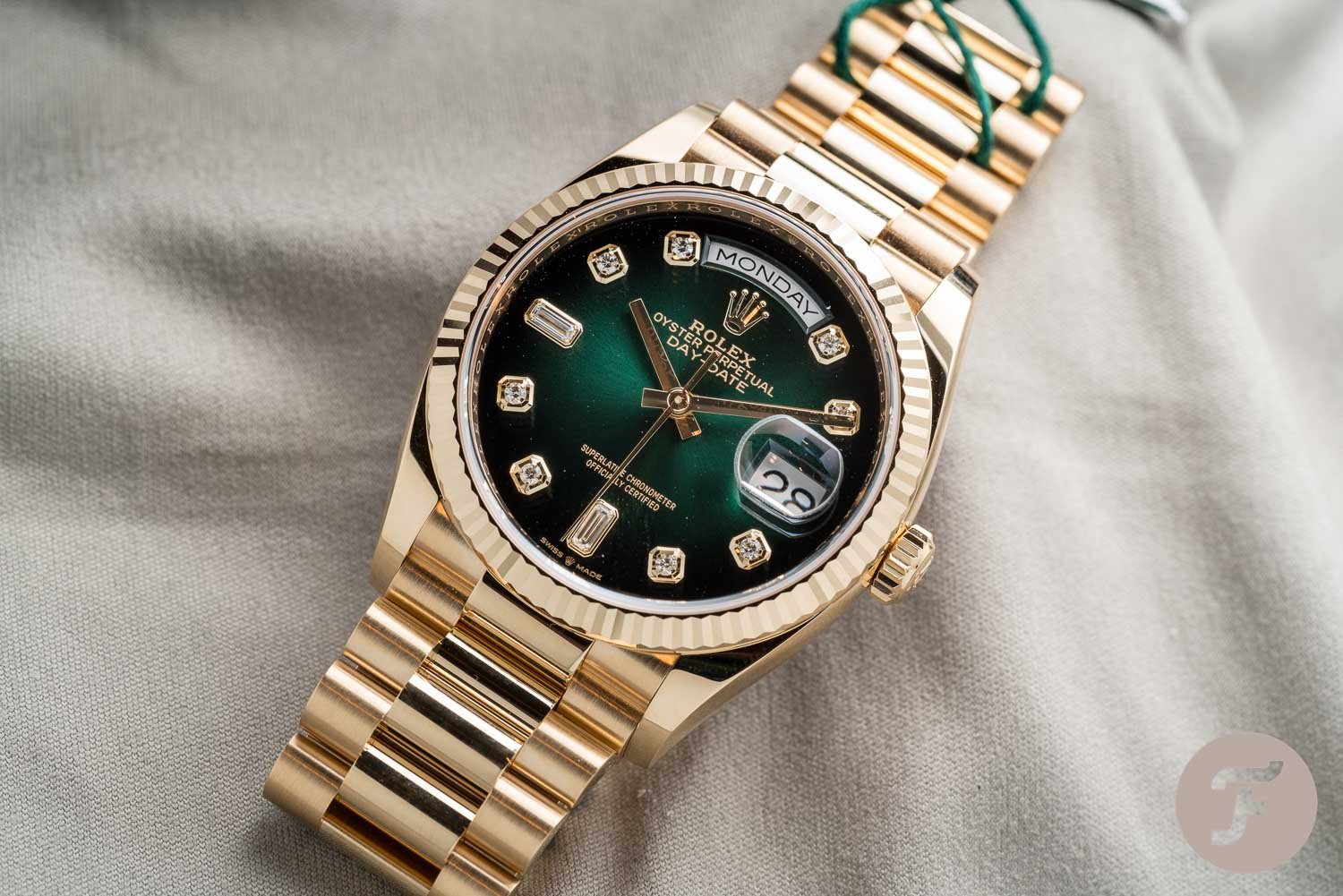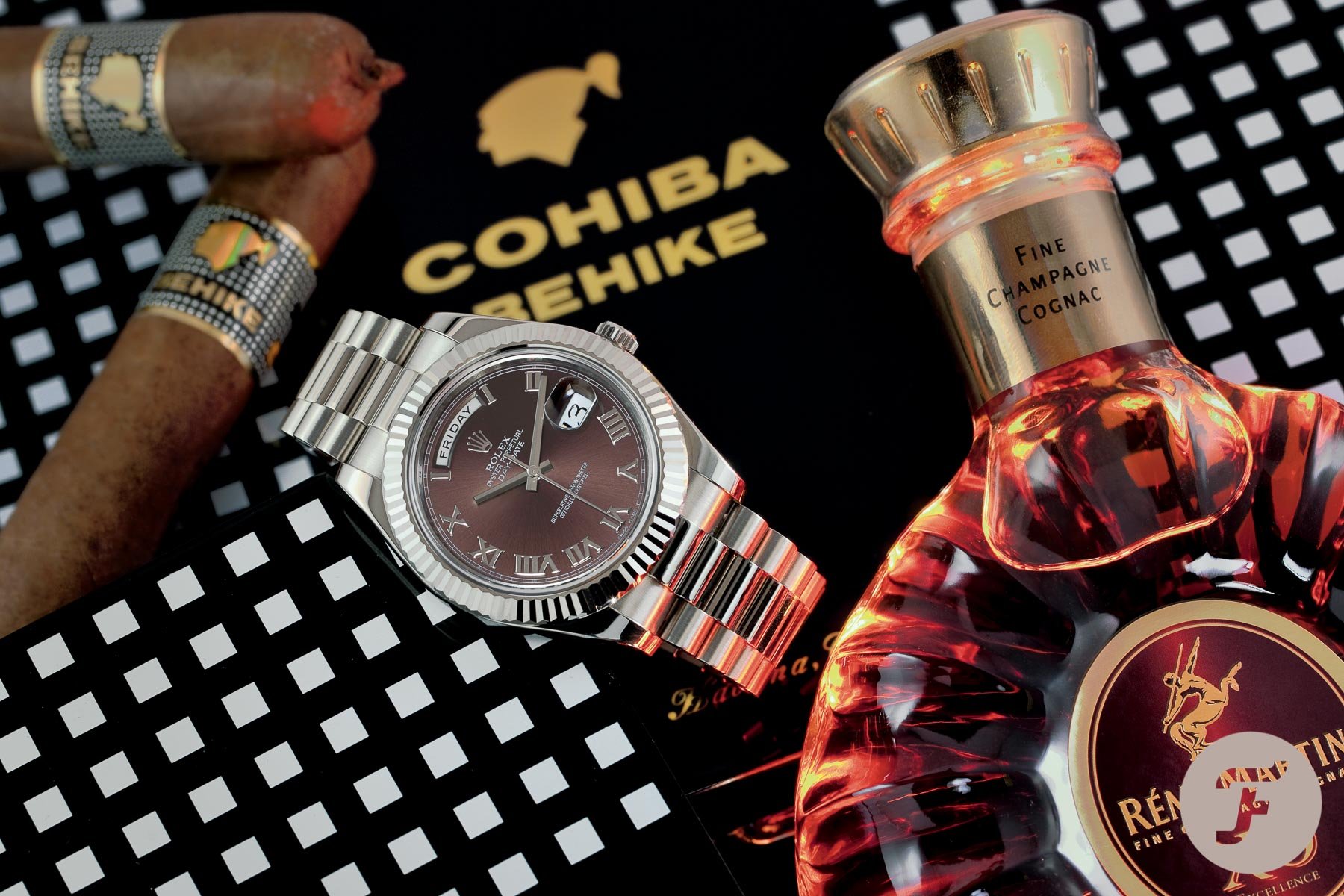Rolex Day-Date – Historical Overview Of Rolex’s Flagship
Millennials might associate the Rolex Day-Date with fictive characters like Tony Soprano, but there’s much more to this watch, of course. The Rolex Day-Date is the watch worn by Presidents, captains of industry, people from the entertainment industry, and all those who appreciate a timeless watch in precious metal.
My first encounter with the Rolex Day-Date was relatively late. In the small village where I grew up in the 1980s and 1990s, there weren’t many people that spend on luxury items. They were all over on tv-series and movies, though, and advertisements. Rolex is known to have some pretty fantastic ads, and many of them included the famous Rolex Day-Date, featuring people like Arnold Palmer, Jack Nicklaus, Plácido Domingo, Eric Clapton and so on. These advertisements made a huge impression, but it is still nothing compared to the feel of actually wearing one.
My first Rolex Day-Date encounter
The moment I put one on my wrist was in my early 20s, still being a student. Gerard owned a beautiful Rolex Day-Date reference 18038 and felt confident enough to lend it to me for a few days. I felt like a King. The watch, on President bracelet, was heavy and combined with the tapestry dial, simply looked stunning. But, being so young with such an expensive full gold watch, I also felt uncomfortable. I was not in the position to buy one anyway, but the impression it left on me was two-fold.
On the one hand, the Rolex Day-Date on a President bracelet is something not for everyone due to the gold and the exposure you generate with it, which is not always either positive or welcome. On the other hand, it is a mighty cool watch that immediately gives you this sensation that you are wearing Rolex’s flagship watch. A flagship watch worn by movie stars, presidents (President L.B. Johnson being the first), and captains of industry. Even if you aren’t any of these, the association is still impressive. I quickly learned that if I’d ever buy one, it would be the 18238 or 18239 (white gold).
Although I love earlier references, such as the 1803 and 18038 references, I would be bothered by the non-quickset for the day and date complication. Only later on, when Rolex introduced their Day-Date II (discontinued) and the Day-Date 40, I started to think that 36mm could be a bit too small for me. The Day-Date II was out of balance for me (and I guess for many others as well, as it quickly left the stage), but with the Day-Date 40, Rolex introduced a better proportioned larger version of their flagship. I tried them all, and for me, there’s only one, the Rolex Day-Date in 36mm. Not because a 40mm would be too large for me, but I like the proportions of the 36mm just better.
Where the Day-Date could be perceived as a watch that was associated with older men having a certain age and reputation, this has changed in recent years. It could also be that I just got older, but I also noticed an increased interest in a gold Day-Date from people that are half my age. And sure I was interested as well in my early 20s, but they now actually are being sold to this younger audience as well. Smart marketing and promotion of these watches by Amsterdam Vintage Watches, for example, clearly aiming at a younger audience, is what helped to grow the Rolex Day-Date again as an ultimate status symbol for many millennials.
Historical Rolex Day-Date Overview
It was just a few years before Rolex founder Hans Wilsdorf passed away (1960) when Rolex introduced their wristwatch that could simultaneously display the day and date on the dial. The first Rolex Day-Date was introduced in 1956, with references 6510 (domed bezel) and 6511 (fluted bezel). This watch, the flagship of Rolex’s collection that was only available in 18-carat gold (white, yellow and rose) and platinum. These two references only lasted for one year, as the successor (6611) was already there in 1957 and had an updated version of the caliber 1055 movement (with free-sprung balance with micro-stella adjustment). This reference was in production till 1959. As you can see below, the hands looked slightly different from the later (and current) Rolex Day-Date models.
The President bracelet was delivered with this watch, but at the time, it didn’t have this name yet. Rolex has used the ‘President’ reference in early advertisements (1966), but it is not entirely clear if that was only meant for the bracelet (as it is today) or the entire watch.
Reference 1803
The next reference, of the third generation, is the Rolex Day-Date 1800-series. Introduced around 1960 as the successor to the 6611(B) and in production till 1978. I will focus on the reference 1803 for now, which is probably the most popular reference of this generation of Rolex Day-Date watches. Introduced with the caliber 1555 movement and later on (ca. 1965) with caliber 1556. This movement had a higher beat rate (19600vph instead of 18000vph). In 1972, the Rolex caliber 1556 movement received a hacking mechanism (to stop the seconds when setting the time). Neither the date or day had a quick-set mechanism, that would only be solved much later. The Rolex Day-Date reference 1803 was available with leather strap and bracelet (in precious metal) and it was the last model to come with the pie-pan shaped dial. The pie-pan shape is not as extreme as those on the Omega Constellations from the 1960s, but it does have an elegant effect on the dial. Later references have a flat dial, which does make the watch appear to be larger, while the diameter is all the same (36mm). In the 1800 series, Rolex also used the new hands-set. Straight hands instead of the leaf-shaped ones on the 6611 and its predecessors. At the time, the Day-Date was available with a weekday indicator in 24 different languages (today in 26 languages: English, Spanish, Dutch, Indonesian, Italian, Japanese, Latin, Arabic, German, Polish, Portuguese, Russian, Chinese, Danish, Basque, Catalan, Ethiopian, Finnish, French, Greek, Hebrew, Moroccan, Norwegian, Farsi, Swedish and Turkish).
Reference 18038
The reference 18038 was quite a game-changer for the Rolex Day-Date in 1978, although, at first sight, it pretty much looks the same as the 1803. As mentioned earlier on, the dial lost its pie-pan shape. The Rolex Day-Date with the 5 digit reference number was the first to receive the sapphire crystal. Part of the attraction in the 1800 series is the plexi crystal (as well as the pie-pan dial), but the 18038 should be considered superior to the 1803 when it comes to quality and functionality. It is equipped with the more advanced Rolex caliber 3055 movement, which ticks at 28800vph and features a quickset for the date. This way, at least the wearer could quickly advance the date on his Day-Date. It is also referred to as a single quickset, as the weekday complication still needed to be set by moving the hour and minute hands. There are a lot of sub-references for the 18000 series, but we stick to the 18038 to keep it simple and easy to digest. The 18000-series were in production for 10 years, as the successor was introduced in 1988. During the production years of the 18000-series, the number of available languages for the weekday indication was 25. We did a review on the 18038 here.
More or less at the same time as the 18038, Rolex also introduced their Oysterquartz collection, including a Day-Date. These 19000 references (the 19018 is the OQ equivalent of the 18038/18238) watches were in production between approx. 1977 and 2001 and used – as its name suggests – a quartz movement with the same functions as the mechanical movement. Introduced with caliber 5033 and at the end of the lifecycle, the models came with a caliber 5355 movement. More information on Oysterquartz models and movements can be found here.
References (1)18238
In 1988, Rolex introduced a new movement for the Day-Date generation, caliber 3155. This movement was quite an improvement (again) over the 3055. It the first Rolex movement to have a double quickset function, making it very easy to correct the weekday and date. The movement construction also changed a bit, and the escapement was now attached to a double bridge. This movement was first used in the Rolex Day-Date reference 18200 series. Again, for this article, we take a look at the 18238. A Day-Date in yellow gold with President bracelet. This series was in production from 1988 till 2000, and available in many different configurations (several dial configurations, smooth/fluted bezel, etc.). In 2000, the Rolex 18000-series was replaced with the 118000-series. An extra digit was added to the reference number, mainly to indicate that the Day-Date from now on had a new bracelet. Also available for the 18000-series were the (Super)Oyster-bracelet in gold as well as a series of leather straps with special end-pieces. Where the bracelets of the 18238, for example, still had hollow center links, it also received an upgraded clasp. As a result, the weight of the bracelet (and thus watch) increased significantly.
In 2013, Rolex introduced a series of Day-Date models in 36mm with a leather strap and special endpieces in precious metal. These Day-Date models (reference 118138) were available in several dial colors with matching straps.
Reference 228238
Already in 2008, Rolex introduced the Day-Date II (218238). A new Day-Date variation on steroids, you could say. Rolex increased the diameter to 41mm but seemed to have some issues with maintaining that perfect profile (and ratios) of the watch. This reference was only short-lived (relatively), as in 2015 Rolex introduced the Day-Date 40 (referring to the 40mm case size). Below, a reference 228238 model from the Day-Date 40 collection. In this Day-Date 40 collection, all watches are equipped with the new Rolex caliber 3255 movement. It is quite a step-up from the previous caliber 3155 movement and features the Chronergy escapement and Parachrom hairspring. The power-reserve is now 70 hours, and Rolex guarantees an accuracy of -2/+2 seconds per day on average. But, what’s even more important, at least to me, is that Rolex achieved the get the proper aesthetics for this 40mm Day-Date. It is much more elegant than the previous Day-Date II.
References 218238
We’re not done yet! The life-cycle of the 36mm Day-Date 118238 was long due and I was actually a bit afraid that it would be replaced by the Day-Date 40. In 2019, Rolex introduced the Day-Date 36. Rolex restyled the case profile and lugs a tiny bit, making them (even) more elegant. Also here, Rolex used their caliber 3255 movement as they did in 2015 already in their Day-Date 40. Both the Day-Date 36 and Day-Date 40 can be configured online via Rolex.com and it is worth to go through a few variations between making a decision.
That Perfect Rolex Day-Date
One of the cool things about the Rolex Day-Date is that you have so many variations, so you can get one that really fits your style and personality. Or start a collection (comes in handy if you have a split personality). Within the Fratello team, there aren’t many Day-Date models floating around. I think it is limited to a 1803 and a 18239 if I am not mistaken. When I was younger, I was leaning a bit more towards a white gold version, like the 18239. But now that I am a bit older, I think I would be very comfortable with a Day-Date in yellow gold. My favorite Rolex Day-Date reference remains to be the 18238/118238. The picture showing the 118238 with the tapestry in this article is actually my wrist and taken during a Day-Date exhibition here at a local authorized Rolex dealer in The Hague, The Netherlands a few years ago. I know that others prefer to have the more massive (and perhaps masculine) Day-Date 40, in white gold. As pictured below.
Whether you go for a modern white gold reference in 40mm or like to stick with the vintage 1803 with a plexi crystal, you won’t be disappointed for sure. The Rolex Day-Date is an icon, but it’s perhaps not for everyone out there. Not only due to the relatively high price point due to the use of precious metal, but also because of the style. If it is something for you, the good news is, that you will be able to find a vintage Rolex Day-Date on a leather strap around the €5500 mark. However, part of the joy of owning a Rolex Day-Date for me would be to have it on a President bracelet. That will have a significant impact on the price, as it will then be more in the €10.000 ballpark. I noticed that prices in the USA for these watches are a bit lower than here in Europe. This might have to do with the amount available in the pre-owned market in the USA, which is much higher than anywhere else in the world. For Europeans, that’s not very interesting to purchase from given the custom procedures and fees you have to deal with. Make sure to do your homework in advance. An excellent place to start would be a little investment in the Day-Date book by Mondani.
The new Rolex Day-Date 40 starts at €32.200 (including VAT) and the Day-Date 36 at €29.200 (including VAT).
Click here for all our Rolex coverage. Submariner History. GMT-Master History.

